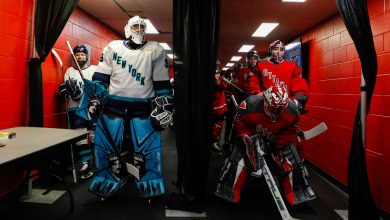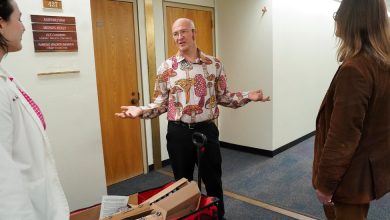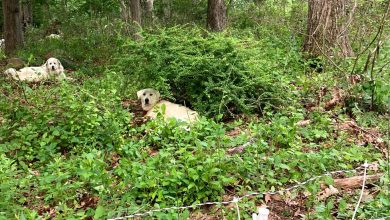Answering the Call of the Wild With a Dog-Sled Trek

Our dog-sledding guide — the guy with the icicle’d beard — had already released three sets of dog teams hauling gear and inexperienced tourists into the Maine winter wonderland. It was my turn. I felt clumsy in my multiple Teletubbies layers and a bit worried that I wouldn’t remember the recently shared instructions about how to handle my team of dogs.
As the guide unhitched my sled, he issued a final warning: Remember the brake!
And then we were off. A sudden jerk, a crunch as I released the brake. Except for the faint hiss of sled runners on snow, the whole world went silent. Twelve paws padded soundlessly on the snow ahead. There was the white-and-black leader, Olga, surprisingly small for her big job, followed by Teslin and Layla, both bigger and brown and black.
For a few hours, our little band of dog-sledders carved a canine-human calligraphy across the snowy white canvas of Lake Umbagog in Southern Maine. A line from “The Night Before Christmas” came to me: “As dry leaves that before the wild hurricane fly/ when they meet with an obstacle, mount to the sky. /So up to the house-top the coursers they flew/ with the sleigh full of toys, and St. Nicholas too.”
My coursers, they flew.
Canine joy
Anyone who has watched a dog rolling in fresh snow must agree with 19th-century social reformer Henry Ward Beecher’s observation that the dog is the god of frolic. Who doesn’t need more of that particular god in the plague season? During the long lockdown months last winter, I mainlined canine joy by getting my Border collie to pull me around on my skis, unaware that this is an actual Scandinavian sport called hundjoring.
It turns out that dogs and humans have a long history together in the snow. Some scientists argue human survival in the Arctic would have been impossible without them. Dogs were crucial to human migration to the Americas, over the ice between the Siberian peninsula and what is now Alaska 25,000 years ago. Sled dogs probably evolved in Mongolia between 30,000 and 35,000 years ago, according to the American Kennel Club. Archaeologists have found dog remains with harnesses in Siberian sites from 6,000 years ago.
The late 19th and early 20th centuries were the heyday of mushing, the era of Jack London’s “Call of the Wild.” Dogs pulled sleds around Canada and what is now Alaska for traders, explorers and gold miners. (The word “mush” comes from the English mispronunciation of “marche” the French word for march.)
Besides Buck, the hero dog of “The Call of the Wild,” the most famous sled dogs in history are 20 huskies who ran 674 miles in 1925 to fetch diphtheria antitoxin to save the gold rush town of Nome, then an Alaska village threatened by a diphtheria epidemic. Balto, the lead dog on the 53-mile final leg, has his own statue in Central Park (plus a book and movie), although some say the more deserving dog was 12-year-old Togo, who ran 274 miles, compared to the average 31 miles the other dogs ran.
But now, the snowmobile has largely replaced the dog in Arctic zones. Climate change is diminishing the icy territory of many Arctic inhabitants, from polar bears to walrus to Indigenous people. Sled dogs are now mostly bred to race (the Iditarod is the most famous, although even it is melting away) and for recreation. Tourists can hire outfitters in Alaska or the Yukon who run seven-day mushing trips under the aurora borealis. More kid-friendly, afternoon sled-dog excursions are available in New Hampshire, Vermont, Quebec and Maine.
“It’s a lot like sailing”
In early January, my husband, Erik, and I opted for a mushing middle ground — a two-day, out-and-back camping trip by dog sled near the town of Newry, Maine, which is on the edge of the White Mountain National Forest, an hour and a half from Portland.
Driving seven hours north of New York City, we arrived on the frozen shores of Lake Umbagog. Gusts of wind lashed the frosted lake. Ghostly snow devils, hundreds of feet tall, twirled down the sides of the piney mountains nearby.
If you want to go dog-sledding, you have to get good and cold. Parking, we noted the dashboard exterior temperature had dropped to four degrees.
Our Maine guides, Kevin Slater and Polly Mahoney, the owners of Mahoosuc Guide Service, went north as young adults, and have decades of expedition experience in the Yukon and eastern Canada, north of Baffin Bay. Since the 1990s the couple has been breeding and training sled dogs on their farm in Newry. They keep a kennel of active sled dogs and another for their retirees. A cemetery with wooden markers near their farmhouse commemorates the lives and personalities of dogs that have “walked on,” as Kevin put it.
Sled dogs are large — on their hind legs, some stand, eye to eye, at six feet. They’re also surprisingly soft and cuddly, with an inner coat of fur, which they shed in summer. They seem to live to have their ears and backs stroked. Affability is no accident: Mushers select dogs as much for responsiveness to humans as strength.
“It’s a lot like sailing,” Polly explained, as she arranged the complicated rope-and-harness system on the snow, and we started latching the dogs. The dogs were clearly anticipating takeoff. Even harnessed, they were rolling over, coating themselves in the cold white powder.
Before we set off, Polly unloaded a rapid-fire mushing primer that could be boiled down to “never, ever take your hands off the sled.” Many a selfie-snapping recreational musher has fallen off and lost the team while Instagramming.
As for commands, quiet and gentle was the goal. Sled dog hearing is finely tuned to human voices and moods. They are always listening to us. Once we started moving, we would speak low to them and not talk with human companions because that could confuse them. To stop them, we’d say said quietly, “whoa.” To go, first “tighten up” — the signal to pull their ropes taut — and then “Let’s go.”
I never lost my sled. I remembered the brake! The dogs responded to my foot gently pressing down on the brake, and to my commands. Woman and beast were in sync. I leaned the sled left or right as the trail wove between hillocks of snow-covered rock and birch trunks. The dogs followed their canine leaders and the guides ahead.
Eventually, we pulled into our camp, unloaded and hitched the dogs to low posts in a circle around the campsite. We laid fresh hay for each one. Curled on their nests, two dozen pairs of eyes watched us walking back and forth collecting buckets of icy water from holes in the lake, cutting wood, starting fires in the stoves. They didn’t make a sound until the next morning, when they howled in unison just before we were ready to leave.
As we settled in for the night, the Mahoosuc Mountains, across the lake, turned pewter against a pink sunset. Dusk fell, then total darkness. Orion wheeled cockeyed over the horizon, confusingly low compared to its customary place over the southerly latitudes.
The cold was even more intense in the darkness. We were suddenly starving. The dogs ate first — dry dog food and steaming chunks of freshly cooked pork off metal plates. Then we devoured rice, burgers and whoopie pies off our own metal plates.
Around a bonfire, our guides told a few Arctic yarns that had the flavor of tall tales: surviving 65 below zero temperatures, being followed by lone wolves, sleeping beside the dogs with a rifle to protect them. A few years ago, they delivered a pack of sled dogs banished from Antarctica to an Inuit village, 500 roadless miles of wilderness along Hudson Bay. The Antarctic treaty had just banned all nonnative species and the dogs would have been euthanized. En route, a storm dropped eight feet of snow and they were trapped for several days.
Kevin recited a long poem by Robert Service, along with Jack London one of the bards of the Yukon, called “The Cremation of Sam McGee.” After 15 raucous stanzas, it turns out “Sam McGee from Tennessee” could not bear the cold and was last seen grinning happily inside a crematorium’s roaring fire.
It was only 8 p.m., but, like Sam McGee, I was ready to ignite my borrowed mukluks. We retreated to our surprisingly elegant tents with white canvas walls and a thick carpet of soft pine boughs on the floor, packed wood into the little stoves and zipped ourselves into double sleeping bags. I woke up once during the night. Of course, the fire was out, but I was warm. I felt around in the Stygian darkness by my head for pen and notebook and tried to express some profound sentiment about man and beast, but the ink was frozen and my scribble made no sense by daylight.
I remember thinking about things my frozen pen couldn’t put down, about the thin wall between civilization and human life on this essentially inhospitable piece of earth, thin as a canvas tent wall. Warm showers, chocolate, electricity, the bikini: All seemed unreal from inside the silent forest. I thought of primitive men and women in their caves. I thought of Mars and of Matt Damon on Mars.
And I thought of the dogs, cryptic, soulful, loyal animals, warm in their pelts, just outside. Tamed by and allied with humans, but wild enough to know better than we what lurks in the dark.
Nina Burleigh is a journalist and author, most recently, of Virus: Vaccinations, the CDC and the Hijacking of America’s Response to the Pandemic.
Follow New York Times Travel on Instagram, Twitter and Facebook. And sign up for our weekly Travel Dispatch newsletter to receive expert tips on traveling smarter and inspiration for your next vacation. Dreaming up a future getaway or just armchair traveling? Check out our 52 Places list for 2022.



